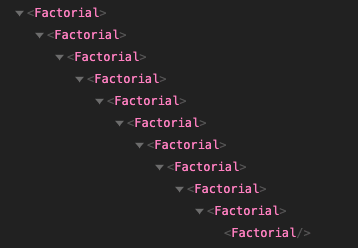Factorial
The product of (= the result) a whole number and all the whole numbers below it
Four factorial (4 x 3 x 2 x 1) is 24
Goal
Create a Factorial component which will calculate the answer recursively using only templates and helpers.
Step 1 - How to calculate factorial using recursion
Let's first see how to solve the factorial using recursion in JS land
function factorial(number) {
if(number === 0) return 1; //when we get to the base case it returns 1.
return number * factorial(number-1) //Recursion, we are calling factorial again with n-1
}
factorial(3) //6
Step 2 - Factorial Component
Let's write the same, but using ember templates (this is not the final version), it's purpose is to show similarity with the js equivalent
eq is a helper to test equality {{eq "hola" "bye"}} = false
sub is a helper to subsctract something {{sub 5 1}} = 4
mult is a helper to multiply something {{mult 5 2}} = 10
You can find these helpers and more at
{{! factorial.hbs}}
{{#if (eq @number 0)}}
{{return 1}} {{! when we get the base case, it retuns 1.}}
{{else}}
{{return
(mult @number <Factorial @number={{sub @number 1}} />)
}} {{! Recursion, we're calling factorial again with n-1}}
{{/if}}
This algorithm seems correct, and conceptually this is the same as the JS equivalent, but it has some errors.
First, when you want to return something in ember templates, you use yield keyword instead of return
{{! factorial.hbs}}
{{#if (eq @number 0)}}
{{yield 1}} {{! when we get to the base case, return 1.}}
{{else}}
{{yield
(mult @number <Factorial @number={{sub @number 1}} />)
}} {{! Recursion, we're calling factorial again with n-1}}
{{/if}}
By last, this is the difficult part where we find ourselves a bit lost, whereas it can actually yield or "return" a component
{{yield (component 'factorial' @number=(sub @number 1)}}
This component would not actually run, so the client of this code would need to do something like this.
{{#let 10 as |number|}}
<Factorial @number={{number}} as |Factorial|>
<Factorial />
</Factorial>
{{/let}}
Which actually does nothing because we are never getting the answer.
Here's the solution
{{! factorial.hbs}}
{{#if (eq @number 0)}}
{{yield 1}} {{! when we get to the base case, return 1.}}
{{else}}
{{! Recursion, we are calling factorial component again with n-1}}
<Factorial @number={{sub @number 1}} as |answer|>
{{yield (mult @number answer)}}
</Factorial>
{{/if}}
By yielding the multiplication of the current number times the response of another factorial(n-1) (inside the block), we just covered the recursion.
Here's the final Component "API".
{{#let 10 as |number|}}
<Factorial @number={{number}} as |answer|>
<h1>{{number}}! is {{answer}}</h1>
</Factorial>
{{/let}}
Finally if we wish to visually display or render the recursive tree nicely, we could use the <ul> tag
{{! factorial.hbs}}
{{#let
(array "red" "blue" "yellow" "orange" "pink") as |colors|
}}
<ul style="background-color: {{object-at (mod (sub @number 1) colors.length) colors}};">
{{#if (eq @number 0)}}
{{yield 1}} {{! when we get to the base case, return 1.}}
{{else}}
{{@number}} * factorial({{sub @number 1}})
{{! Recursion, we are calling factorial component again with n-1}}
<Factorial @number={{sub @number 1}} as |response|>
{{yield (mult @number answer)}}
</Factorial>
{{/if}}
</ul>
{{/let}}
And the Ember inspector would look like this!
Here's a demo
Why using templates instead of pure JavaScript?
Ember templates rerender automatically when some value (must be a @tracked decorated property or an Ember.Object property) referenced in them, changes, this means that we could have an observed recursion. Our components tree can actually make smart decisions, so we can have a recursive logical tree that recalculates on arbitrary events, like clicking a button that might increment a property referenced by the template thus, triggering a rerender, etc. In other words, we can take advantage that ember templates already know exactly when to "rerender" as effective observer(s) of our recursion.
You can of course solve these kind of problems also by adding observers in your components js class, or some other technique, which is usually way more verbose and would need some kind of hand wiring observers via addObserver and then destroy them if the component gets destroyed.
About our use case
This short blog post is about something I learned with my colleagues today while trying to calculate a value using a recursive technique on ember templates, which we finally did not use.
Our use case was very strange and specific, we wanted a way to reduce a complex nested object (flatten an object) to create a live array, so a client could iterate on. This "live" stuff would use the templates "observavility" and automatic "rerenders" to effectively observe an external dependency, i.e. DS.Model instance, because the flattening process has logical branches based on the DS.Model properties actual values (referenced in the templates). Since any change in DS.Model would cause a complete rerender, and the performance implications were dire, we chose other path.




Top comments (0)